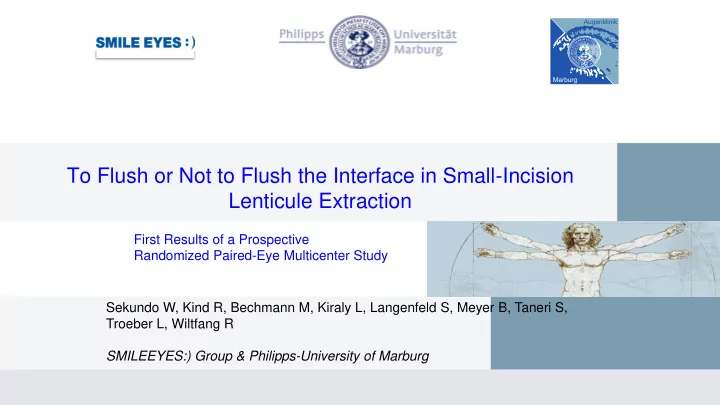

� To Flush or Not to Flush the Interface in Small-Incision Lenticule Extraction First Results of a Prospective Randomized Paired-Eye Multicenter Study Sekundo W, Kind R, Bechmann M, Kiraly L, Langenfeld S, Meyer B, Taneri S, Troeber L, Wiltfang R SMILEEYES:) Group & Philipps-University of Marburg
Aim and Methods Purpose: to investigate the outcome differences in uncomplicated bilateral simultaneous SMILE with and without interface flushing with BSS after the removal of the refractive lenticule • Single blinded prospective study at 6 Laser Refractive Centers of the SMILEEYES :) group • Approved by the Ethics Committee of the Philipps University • Randomization for flushing left or right eye using envelope method Folie 2 von 11 �
Background and Methods (2) • Surgeries performed by 9 different surgeons of the SMILEEYES group • Analysis was performed comparing flushed and not-flushed eye of the same patient ( paired t-test) by an independent investigator (Ralph Kind) • In planned cases of under-correction (mini-monovision for presbyopia) the target refraction was put in front of the under-corrected eye to get a comparable “UDVA” Folie 3 von 11 �
Study demographics and data (1) • Requirement – MRSE: -1 to -12 D – Maximum difference between both eyes < 2 D – CDVA before surgery at least 20/25 (0.8 decimal) for both eyes – Laser (VisuMax) settings • Lenticule and cap diameter of same size in both eyes • Cap thickness between 120 and 130 µm • Flushing of the pocket using 1ml of BSS via a single use 27 G cannula Folie 4 von 11 �
Study demographics and data (2) • 264 patients were enrolled at 6 study centers • Excluded: – 7 patients with complications during surgery – 22 patients with an incomplete follow up – • 470 eyes of 235 patients for final analysis – Age: mean 32.8y, range (18y-56y) – Refraction: • Sphere: mean -3.97 D ± 1.99 D • Cylinder: mean -0.89 D ± 0.77 D • Low myopia (-3 D <): 66 Patients • Moderate myopia (-3 to -6 D): 114 Patients • High myopia (> -6 D): 55 Patients Folie 5 von 11 �
Results: decimal UDVA for all 470 eyes Results (235 Patients) 1,20 p-value: 1d: 0.1329 1,10 1w: 0.2079 3m: 0.1719 20/20 1,00 UDVA 0,90 Not-flushed Flushed 20/25 0,80 0,70 0,60 1d 1w 3m Time after surgery Folie 6 von 11 �
Moderate myopia (114 patients) 1,20 Results: subgroups 1,10 1,00 UDVA 0,90 Not-flushed Flushed 0,80 Slight myopia (66 patients) 1,20 0,70 1,10 0,60 1d 1w 3m 1,00 Time after surgery UDVA 0,90 Not-flushed Severe myopia (55 patients) Flushed 0,80 1,20 0,70 1,10 0,60 1,00 1d 1w 3m UDVA Time after surgery 0,90 Not-flushed Flushed 0,80 Low myopia 0,70 0,60 1d 1w 3m Time after surgery Folie 7 von 11 �
Decimal UDVA & CDVA for all 470 eyes @ 3/12 3-month follow-up 1,4 1,2 1 1.04 1.06 1.15 1.17 visual acuity 0,8 0,6 0,4 0,2 0 Not-flushed UDVA Flushed UDVA Not-flushed CDVA Flushed CDVA �
Complications intraoperative • Relevant intra-operative complications ( excluded from follow-up): 7 patients – 4 patients: multiple or both sided flushing due to stuck parts of lenticule – 2 patients: conversion to PRK due to suction loss at one eye – 1 patient: conversion to PRK because conjunctiva was pulled into interface at both eyes • Minor intra-operative complications: 23 eyes – Cap tear at the incision site: 4 eyes – Epithelial defects: 8 eyes – Difficult dissection, minor remaining lenticule’s edge, bleeding at the incision site Folie 8 von 11 �
Complications (postoperative) • 19 eyes with minor postoperative complications – haze, – dry eye symptoms, – superficial punctate keratitis, – diffuse lamellar keratitis stage 1 Folie 9 von 11 �
Conclusion & Outlook • No statistical difference between the flushed and unflushed eyes • Tendency for a better UDVA/CDVA for flushed eyes regardless of preop refraction, but never reached statistical significance (p ≥ 0.05) • Maybe larger group of patients (> 2000) would get p<0.05 • Overall high efficacy (UDVA @ 3 month follow-up with average > 1.0) – The UDVA better in low myopias (< -3D) • To-do: – Check for relationship between UDVA and minor complications – Compare OCT-data with UDVA – Compare, if flushing/non-flushing has any impact on refractive predictability Folie 10 von 11 �
Special thanks to the surgeons and their teams • Cologne: Dr. B. Meyer • Leipzig: Dr. L. Kiraly • Marburg: Prof. Dr. W. Sekundo • Munich: Dr. R. Wiltfang & Dr. M. Bechmann • Munster: Dr. S. Taneri • Trier: Dr. L. Troeber Folie 11 von 11 �
Results: decimal UDVA and CDVA for all 470 eyes 1,40 CDVA 1,20 UDVA 1,00 0,80 visual acuity 0,60 0,40 0,20 0,00 1d 1w 3m Not-flushed UDVA Flushed UDVA Not-flushed CDVA Flushed CDVA �
Comparison between difference of CDVA and UDVA for flushed and not-flushed eyes 1,2 1,15 1,1 1,05 1 0,95 0,9 0,85 0,8 not-flushed UDVA flushed UDVA not-flushed CDVA flushed CDVA visual acuity difference between CDVA and UDVA
Recommend
More recommend